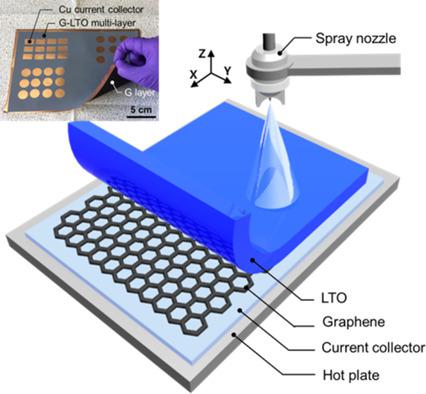当前位置:
X-MOL 学术
›
Energy Technol.
›
论文详情
Our official English website, www.x-mol.net, welcomes your
feedback! (Note: you will need to create a separate account there.)
Scalable Multilayer Printing of Graphene Interfacial Layers for Ultrahigh Power Lithium‐Ion Storage
Energy Technology ( IF 3.6 ) Pub Date : 2020-05-04 , DOI: 10.1002/ente.202000253 Sang Ho Lee 1 , Colin Johnston 1 , Patrick S. Grant 1
Energy Technology ( IF 3.6 ) Pub Date : 2020-05-04 , DOI: 10.1002/ente.202000253 Sang Ho Lee 1 , Colin Johnston 1 , Patrick S. Grant 1
Affiliation

|
A low resistance graphene‐based interfacial layer is developed for multilayered lithium‐ion capacitor electrodes using a layer‐by‐layer printing approach, with the goal of boosting energy storage performance at ultrafast charge/discharge rates (≥100 C). The electrochemical behavior of spray printed Li4Ti5O12‐based heterostructure electrodes is investigated as a thin, discrete graphene layer is placed: 1) at the base of the Li4Ti5O12 (at the electrode/current collector interface); 2) on the top of the Li4Ti5O12 (at the electrode/separator junction); and 3) both at the base and on the top of the Li4Ti5O12 (sandwich configuration), with marked improved electrode performance at >50 C when the graphene layer is interleaved at the Li4Ti5O12/current collector interface. This best performing heterostructure negative electrode is then coupled with a spray printed activated carbon positive electrode in a lithium‐ion capacitor configuration, showing an attractive power density of ≈8000 W kg−1 at 350 C. The fabrication of double‐sided graphene/Li4Ti5O12 multilayered heteroelectrodes is successfully demonstrated over areas of 20 cm × 15 cm and in various patterned configurations.
中文翻译:

石墨烯界面层的可扩展多层印刷,用于超高功率锂离子存储
低电阻石墨烯界面层是采用逐层印刷方法开发的,用于多层锂离子电容器电极,目的是在超快充电/放电速率(≥100 C)下提高储能性能。研究了喷涂印刷的Li 4 Ti 5 O 12基异质结构电极的电化学行为,方法是:放置一层离散的石墨烯薄层:1)在Li 4 Ti 5 O 12的底部(电极/集电器界面) ; 2)在Li 4 Ti 5 O 12的顶部(在电极/隔板接合处);和3)在锂电池的底部和顶部4 Ti 5 O 12(三明治结构),当石墨烯层在Li 4 Ti 5 O 12 /集电体界面处插入时,在> 50 C时,电极性能得到显着改善。然后,该性能最佳的异质结构负极与锂离子电容器配置中的喷印活性炭正极耦合,在350℃下显示出约8000 W kg -1的有吸引力的功率密度。双面石墨烯/锂的制造在20 cm×15 cm的区域和各种图案化配置中成功地展示了4 Ti 5 O 12多层杂电极。
更新日期:2020-07-02
中文翻译:

石墨烯界面层的可扩展多层印刷,用于超高功率锂离子存储
低电阻石墨烯界面层是采用逐层印刷方法开发的,用于多层锂离子电容器电极,目的是在超快充电/放电速率(≥100 C)下提高储能性能。研究了喷涂印刷的Li 4 Ti 5 O 12基异质结构电极的电化学行为,方法是:放置一层离散的石墨烯薄层:1)在Li 4 Ti 5 O 12的底部(电极/集电器界面) ; 2)在Li 4 Ti 5 O 12的顶部(在电极/隔板接合处);和3)在锂电池的底部和顶部4 Ti 5 O 12(三明治结构),当石墨烯层在Li 4 Ti 5 O 12 /集电体界面处插入时,在> 50 C时,电极性能得到显着改善。然后,该性能最佳的异质结构负极与锂离子电容器配置中的喷印活性炭正极耦合,在350℃下显示出约8000 W kg -1的有吸引力的功率密度。双面石墨烯/锂的制造在20 cm×15 cm的区域和各种图案化配置中成功地展示了4 Ti 5 O 12多层杂电极。









































 京公网安备 11010802027423号
京公网安备 11010802027423号